Detailed Outline and Thematic Analysis of Bharat Muni's Natyashastra
Bharata Muni's Natyashastra, an ancient Sanskrit treatise composed between 200 BCE and 200 CE, has profoundly shaped Indian classical theater, dance, and music. This comprehensive text, consisting of approximately 36,000 sutras and 6,000 shlokas, serves as a foundational guide for the performing arts in India.
Significance and Influence on Indian Classical Performing Arts
The Natyashastra has been instrumental in codifying the principles of Natya (dramatic art), encompassing acting, emotion, costuming, stage design, and musical accompaniment. This foundational work has given rise to various classical Indian theatrical and dance forms, such as Bharatanatyam, Kathak, Odissi, and classical music traditions like Carnatic and Hindustani music.
The text introduced a system of mudras (hand gestures) and detailed how emotions (bhava) translate into aesthetic experience (rasa), which performers use to communicate complex narratives and spiritual themes. It also addressed recitation, music composition, and theatrical staging, demonstrating an integrated art vision where movement, music, and storytelling are inseparable.
Key Principles and Their Contemporary Impact
Rasa (Aesthetic Flavor/Emotion)
The Natyashastra identifies nine primary rasas—love (shringara), heroism (veerra), humor (hasya), sorrow (karuna), anger (raudra), fear (bhayanaka), disgust (bibhatsa), wonder (adbhuta), and peace (shanta). These emotional essences guide performers to elicit corresponding emotional responses in the audience, maintaining the core of Indian artistic expression. This concept still underpins contemporary classical dance and theater, enabling deep emotional and spiritual engagement.
Abhinaya (Expression/Enactment)
Abhinaya involves physical gestures, facial expressions, and body language employed to convey rasas and stories. The Natyashastra classifies abhinaya into four types: angika (body), vachika (speech), aharya (costume/scene), and sattvika (mental/emotional states). These elements remain central to training and performance practice in classical dance and drama today.
Raga (Melodic Framework) and Tala (Rhythmic Cycle)
The Natyashastra lays rules for musical scales and rhythms to accompany performance, establishing melodic and rhythmic foundations for Indian music that persist in contemporary classical forms. The integration of raga and tala with dance and drama underscores the Natyashastra’s holistic view, where music and movement work together to enrich the aesthetic experience.
In modern times, these principles still inform performance technique, pedagogy, and interpretation across Indian classical arts. They provide a vital link to the ancient artistic and spiritual ethos, enabling artists to innovate while respecting traditional frameworks. The continuing use of Rasa, Abhinaya, Raga, and Tala bridges classical heritage with contemporary creativity, preserving transformative emotional experience as central to Indian performing arts.
Thus, the Natyashastra is not only a scholarly text but a living manual shaping the rhythm, movement, and emotional landscape of Indian classical theater, dance, and music for over two millennia. Its influence sustains the cultural, spiritual, and artistic identity of Indian classical arts in present-day interpretations.
- The Natyashastra's influence extends beyond classical theater and dance, finding a place in contemporary Indian lifestyle, fashion-and-beauty, food-and-drink, home-and-garden, books, education-and-self-development, and entertainment.
- The principles of Rasa, Abhinaya, Raga, and Tala have been applied to modern forms of storytelling and artistic expression, including literature and learning.
- The thematic narratives and spiritual ideas presented in the Natyashastra continue to inspire contemporary Indian authors, providing themes for their literary works.
- Indian fashion designers often employ Abhinaya techniques in their designs, emphasizing the importance of expressive body language and costuming in conveyng emotions.
- The Natyashastra's influence can be seen in the way food and drink are presented in Indian cuisine, with attention given to aesthetics and emotional resonance, much like the rasa principle in performing arts.




